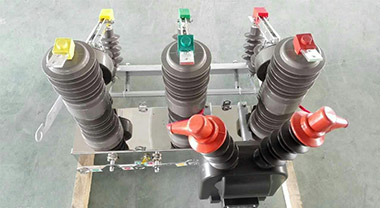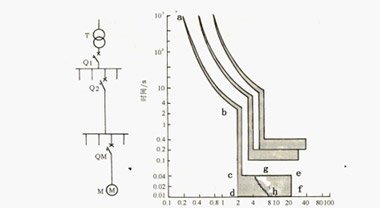The arc extinguishing process of the circuit breaker
In order to improve its breaking capacity, the oil circuit breaker is equipped with an arc extinguishing chamber made of insulating material around the contacts. The arc extinguishing chamber of the oil circuit breaker uses the gas generated by the decomposition of the oil to form a high-speed airflow to blow the arc strongly to extinguish it. Its working characteristic is that the larger the breaking current, the more gas is produced per unit time, the higher the pressure in the arc extinguishing chamber, the stronger the arc blowing force, and the shorter the arcing time; when the breaking current decreases, The arc blowing force is correspondingly weakened, so the arcing time increases.
The arc extinguishing chamber is installed in a high-strength insulation box, which is composed of arc extinguishing pieces, and the arc extinguishing pieces are separated by a certain distance to form an oil bladder. The upper part of the arc extinguishing chamber is a static contact. When the switch is opened, the moving contact moves downward. When the contacts are separated, an arc is generated between the contacts. The arc is surrounded by cylindrical bubbles. The bubble wall is formed by the oil sac of the arc extinguishing chamber. Oil formation. Due to the short distance from the arc to the bubble wall, the oil strongly cools the arc, so that the energy of the arc is consumed in the decomposition and gasification of the oil, and a large amount of gas is generated. As the moving contact moves downwards, the high-pressure gas blows the arc upward through the circular hole in the middle of the arc extinguishing piece. When the distance between the moving and static contacts is long enough, the arc can be extinguished. The longitudinal blowing arc extinguishing chamber has a simple structure, and the gas discharge direction is opposite to the contact movement direction, which is conducive to the cooling of the arc, but the arc time is longer, and the fresh oil is not easy to replenish after arc extinguishing, which is not conducive to reclosing. The arc extinguishing chamber of the low-oil circuit breaker has many structural forms. In addition to the vertical blowing arc extinguishing chamber, there are also horizontal and vertical blowing arc extinguishing chambers.
When the circuit breaker breaks the circuit with current, the moving and static contacts separate to produce an arc. As the movable contact rod moves downwards, the arc is pulled into the arc extinguishing chamber to sequentially contact the oil in the oil sac, causing the oil to evaporate and decompose to form high-pressure oil bubbles. Under the action of the pressure difference, the high-pressure oil and gas pass through the center of the arc extinguishing plate. The circular hole continuously blows the arc upward to cool and extinguish the arc.
Oil circuit breakers belonging to self-energy arc extinguishing, its arc extinguishing capacity is related to the magnitude of arc current. The greater the arc current, the greater the arc energy, the higher the gas pressure generated, the stronger the arc blowing, and the stronger the arc extinguishing ability. When the arc current is small, the arc extinguishing ability is weak. When the current crosses zero, the dielectric strength of the arc gap medium is small and easy to re-shake, and overvoltage will appear when the capacitor current is interrupted.
In order to improve the ability of oil circuit breakers to break small current arcs, modern oil circuit breakers are equipped with oil pressure piston devices. After the static contact seat is equipped with a pressurized oil piston, when the contacts are separated, the spring force pushes the piston down to press the oil under the piston into the arc gap, which can eliminate the "vacuum" phenomenon and quickly improve the insulation strength of the arc gap. Conducive to the extinguishment of small current arcs.
The circuit breaker also adopts the countercurrent principle, and the conductive rod adopts the pull-down type. That is, the opening conductive rod moves downwards, and the high-temperature and high-pressure oil generated by the arc is sprayed upwards, and the charged particles in the arc are quickly discharged upwards from the arc, which is beneficial to the rapid recovery of the arc gap insulation strength. The conductive rod moves downwards to pull the arc downwards, and the lower part of the cold oil is in contact with the arc root, which can reduce the temperature of the arc and the contact, and weaken the thermal isolation. At the same time moving downwards, there is always a part of cold oil squeezed upwards into the arc extinguishing chamber, forming additional mechanical oil blowing, which is extremely beneficial to extinguishing small current arcs.
The amount of oil in the arc extinguishing chamber of a low-oil circuit breaker is small. Under the rated breaking capacity, after one or two breaks, the oil in the arc extinguishing chamber will be carbonized and blackened, and the insulating strength of the oil will be reduced. Therefore, the low oil circuit breaker is not suitable for frequent operation.




